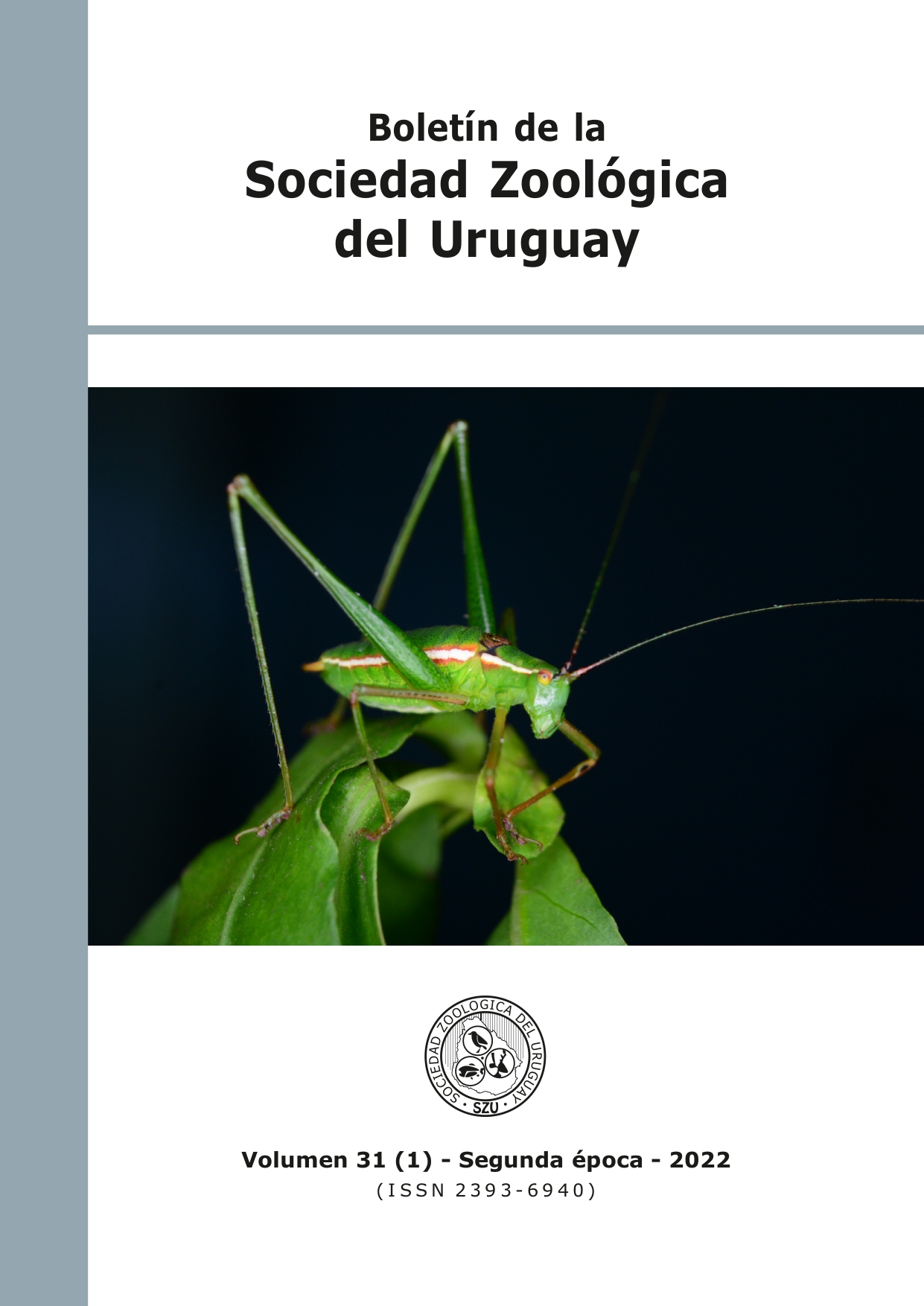DIMORFISMO SEXUAL, REPRODUCCIÓN Y BIOLOGÍA ALIMENTARIA DE Helicops angulatus (LINNAEUS, 1758) (COLUBRIDAE: HYDROPSINI) EN LA AMAZONIA ORIENTAL, BRASIL
DOI:
https://doi.org/10.26462/31.1.1Palabras clave:
Biología, Dieta, Neotropical, Serpiente de agua, Reproducción, OviparidadResumen
Describimos los rasgos de la historia natural de la serpiente de agua de bandas marrones Helicops angulatus de la Amazonia oriental brasilera, una de las áreas más amenazadas de la Amazonia. Registramos información morfométrica, hábitos de alimentación y estrategias reproductivas de 97 hembras maduras, 58 machos maduros y 40 juveniles. Las hembras son más grandes que los machos, aunque los machos tienen mayor largo de cola. Hembras y machos maduran con diferentes tamaños, los machos maduran con tamaños más pequeños. Observamos la presencia de folículos y huevos secundarios durante todo el año. Sin embargo, encontramos dos picos reproductivos, en julio y octubre, correspondientes a la estación seca en la región amazónica. La dieta consiste principalmente en peces, seguida de ranas que utilizan cuerpos de agua para reproducirse. La mayoría de las presas fueron ingeridas de cabeza (82.35%), posiblemente para disminuir el riesgo de lesiones durante la captura e ingestión. Encontramos una relación positiva entre la longitud total de la presa y la longitud hocico-respiradero de las serpientes. En comparación con otras especies, H. angulatus ingiere presas proporcionalmente más grandes (22-44% de la longitud del hocico-respiradero de las serpientes), probablemente optimizando la ganancia de energía.
Descargas
Citas
Aguiar, L.F.S. and Di-Bernardo, M. (2004). Diet and Feeding Behavior of Helicops infrataeniatus (Serpentes: Colubridae: Xenodontinae) in Southern Brazil. Studies on Neotropical Fauna and Environment, 39, 7–14. doi.org/10.1080/01650520412331270927.
Aguiar, L.F.S. and Di-Bernardo, M. (2005). Reproduction of the water snakes Helicops infrataeniatus (Colubridae) in southern Brazil. Amphibia- Reptilia, 26, 527–533. doi. 10.1163 / 156853805774806205.
Albarelli, L.P.P. and Santos-Costa, M.C. (2010). Feeding ecology of Liophis semilineatus (Serpentes: Colubridae: Xenodontidae) in Eastern Amazon, Brazil. Zoologia, 27, 87–91. doi.org/10.1590/S1984-46702010000100013.
Albuquerque, M.F., Souza, E.B.S., Oliveira, M.C.F. and Jr. Souza, J. (2010). Precipitação nas mesorregiões do estado do Pará: climatologia, variabilidade e tendências nas últimas décadas (1978 – 2008). Revista Brasileira de Climatologia, 6,151–68. doi:10.5380/abclima.v6i0.25606.
Alencar, L.R.V., Gaiarsa M.P. and Martins, M. (2013). The Evolution of Diet and Microhabitat.
Use in Pseudoboine Snakes. South American Journal of Herpetology, 8, 60–66. doi.org/10.2994/SAJH-D-13-00005.1.
Almeida-Santos, S.M., Pizzatto, L. and Marques, O.A.V. (2006). Intra-sex synchrony and inter-sex coordination in the reproductive timing of the coral snake Micrurus corallinus (Elapidae). Herpetological Journal, 16, 371–376.
Anderson, M. (1994). Sexual selection. Princenton University Press, Princenton.
Ávila, R.W., Ferreira, V.L. and Arruda, J.A.O. (2006). Natural History of the South American Water Snake Helicops leopardinus (Colubridae: Hydropsini) in the Pantanal, Central Brazil. Journal of Herpetology, 40, 274–279. doi.org/10.1670/113-05N.1.
Bartlett, M.S. (1937). Properties of sufficiency and statistical tests. Proceedings of the Royal Society of London Series A, 160, 268–282.
Bartlett, R.D. and Bartlett, P. (2003). Reptiles and Amphibians of the Amazon. University Press of Florida, Gainesville.
Bonnet, X., Shine, R., Naulleau, G. and Vacher-Vallas, M. (1998). Sexual dimorphism in snakes: different reproductive roles favour different body plans. Proceedings of Royal Society (London), 265, 179–183. doi: 10.1098 / rspb.1998.0280.
Braz, H.B., Scartozzoni, R.R. and Almeida-Santos, S.M. (2016). Reproductive modes of the South American water snakes: A study system for the evolution of viviparity in squamate reptiles. Zoologischer Anzeiger, 263, 33–44. doi.org/10.1016/j.jcz.2016.04.003.
Cadle, J.E. and Greene, H.W. (1993). Phylogenetic patterns, Biogeography, and the Ecological Structure of Neotropical Snake Assemblages. In: PR. E. Ricklefs and D. Schluter (Eds.) Species Diversity in Ecological Communities: Historical and Geographical Perspectives (pp. 281-293). University of Chicago Press, Chicago.
Castello, L., Isaac, V. J. and Thapa, R. (2015). Flood pulse effects on multispecies fishery yields in the Lower Amazon. Royal Society Open Science, 2, 150299. doi: 10.1098 / rsos.150299.
Costa, H.C., Santana, D.J., Leal, F.L., Koroiva, R. and Garcia, P.C.A. (2016). A New Species of Helicops (Serpentes: Dipsadidae: Hydropsini) from Southeastern Brazil. Herpetologica, 72, 157–166. doi.org/10.1655/Herpetologica-D-15-00059.
CPTEC/INPE. (2013). Centro de Previsão de Tempo e Estudos Climáticos. Boletim Técnico Acesso em 29/09/2013. Accessible at http://tempo.cptec.inpe.br/bol_tecnico.shml.
Cundall, D. and Greene, G. (2000). Feeding Snakes. In: K. Schwenk (Ed.) Feeding: Form, Function, and Evolution in Tetrapoda Vertebrate (pp. 293-333). California, EUA: Academic Press.
Cunha, O.R. and Nascimento, F.P. (1993). Ofídios da Amazônia. As cobras a região leste do Pará. Boletim do Museu Paraense Emílio Goeldi, Série Zoológica, 9, 1–191.
Dixon, J.R. and Soini, P. (1986). The reptiles of the upper Amazon basin, Iquitos Region. Milwaukee Public Museum, Milwaukee.
Duellman, W.E. (1978). The Biology of an Equatorial herpetofauna in Amazonian Ecuador. Miscellaneous Publication, 65, 1–352.
Ford, N.B. and Ford, D.F. (2002). Notes on the Ecology of the South American water snakes Helicops angulatus (Squamata: Colubridae) in nariva Swamp, Trinidad. Caribbean Journal of Science, 38, 129–132.
Godoy, M.P. (1975). Peixes do Brasil – Sub-Ordem Characoidei. São Paulo, Brasil: Editora Franciscana.
Greene, H.W. (1983). Dietary Correlates of the Origin and Radiation of Snakes. American Zoologist, 23, 431–441. doi.org/10.1093/icb/23.2.431.
Greene, H.W. and Losos, J.B. (1988). Sistematização, história natural e conservação. Bioscience, 38, 458–462.
Hödl, W. (1990). Reproductive diversity in amazonian lowland frogs. Fortschritte der Zoologie, 38, 41–60.
Isaac, A., Guidelly, G.M, França, J.G. and Pavanelli, G.C. (2004). Composição e estruturas das infracomunidades endoparasitas de Gymnotus spp. (Pisces: Gymnotidae), do rio Baia, Mato Grosso do Sul, Brasil. Acta Scientiarium. Biological Sciences, 26, 453–462. doi: 10.4025/actascibiolsci.v26i4.1527.
Junk, W., Bayley, P. and Sparks, R. (1989). The flood pulse concept in river-floodplain systems. Canadian Special Publication of Fisheries and Aquatic Science, 106, 110–127.
King, R.B. (2000). Analyzing the relationship between clutch size and female body size in Reptiles. Journal of Herpetology, 34, 148–150. doi: 10.2307 / 1565253.
Kovach, W.L. (2016). Oriana – Circular Statistics for Windows, versão 4. Kovach Computing Services, Pentraeth, Wales, U.K.
Kwet, A. and Di-Bernardo, G.C. (1999). Pró-Mata: Anfíbios- Amphibien- Amphibians. Porto Alegre, Brasil: EDIPUCRS.
Lema, T., Araujo, M.L. and Azevedo, A.C.P. (1983). Contribuição ao conhecimento da alimentação e do modo alimentar de Serpentes do Brasil. Comunicação do Museu de Ciências da PUCRS, 26, 41–121.
Linnaeus, C. (1758). Systema naturæ per regna tria naturæ, secundum classes, ordines, genera, species, cum characteribus, differentiis, synonymis, locis. Tomus I. Editio decima, reformata. Laurentii Salvii, Stockholm.
López, M.S. and Giraldo, A.R. (2003). Diet of the large water snake Hydrodynastes gigas (Colubridae) from northeast Argentina. Amphibia-Reptilia, 25, 178–184.
Luz-Agostinho, K.D., Agostinho, A.A., Gomes, L.C., Júlio, H.F. Jr and Fugi, R. (2009). Effects of footing regime on the feeding activity and body condition of piscivorous fish in the Upper Paraná River floodplain. Brazilian Journal of Biology, 69, 481–490. doi.org/10.1590/S1519-69842009000300004.
Marinoni, L. and Peixoto, A.L. (2010). As Coleções Biológicas como fonte dinâmica e permanente de conhecimento sobre a Biodiversidade. Ciência e Cultura, 62, 54-57.
Martins, M. and Oliveira, M.E. (1998). Natural history of snakes in forests in the Manaus region, Central Amazonia, Brazil. Herpetological Natural History, 6, 78–150.
Maschio, G.F., Prudente, A.L.C., Rodrigues, F.S. and Hoogmoed, M.S. (2010). Food habits of Anilius scytale (Serpentes: Aniliidae) in the Brazilian Amazonia. Zoologia, 27,184–190. doi.org/10.1590/S1984-46702010000200005.
Maschio, G.F., Prudente, A.L.C., Lima, A.C. and Feitosa, D.T. (2007). Reproductive Biology of Anilius scytale (Linnaeus, 1758) (Serpentes, Aniliidae) From Eastern Amazonia, Brazil. South American Journal of Herpetology, 2,179–183. doi.org/10.2994/1808-9798(2007)2[179:RBOASL]2.0.CO;2.
Maschio, G.F., Rocha, R.M., Santos-Costa, M.C., Barbosa, L.N.B., Santos, K.S.F. and Prudente, A.L.C. (2021). Aspects of the reproductive biology and feeding habits of Leptodeira annulata (Serpentes, Imantodini) in eastern Amazonia. South American Journal of Herpetology, 19, 85-94. doi.org/10.2994/SAJH-D-17-00080.1
McCallum, L. and McCallum, J.L. (2006). Publication trends of natural history and field studies in herpetology. Herpetological Conservation and Biology, 1, 62–67.
Montag, L.F.A., Freitas, T.M.S., Wosiacki, W.B. and Barthem, R.B. (2008). Os peixes da Floresta Nacional de Caxiuanã (municípios de Melgaço e Portel, Pará - Brasil). The fishes of National Forest of Caxiuanã (Melgaço and Portel municipality, Pará State - Brazil). Boletim do Museu Paraense Emílio Goeldi. Ciências Naturais, Belém, 3, 11–34.
Mushinsky, H.R. (1987). Foraging ecology. Snakes: Ecology and Evolutionary Biology. Foraging Ecology. New York: McMillan.
Nascimento, L.P., Siqueira, D.M. and Santos-Costa, M.C. (2013). Diet, Reproduction and Sexual Dimorphism in the Vine Snake, Chironius fuscus (Serpentes: Colubridae), from Brazilian Amazonia. South American Journal of Herpetology, 8, 168–174. doi.org/10.2994/SAJH-D-13-00017.1.
Nogueira, C.C., Argôlo, A.J.S, Arzamendia, V., Azevedo, J.A., Barbo, F.E., Bérnils, R.S. … Martins, M. (2019). Atlas of Brazilian Snakes: verified point-locality maps to mitigate the Wallacean shortfall in a Megadiverse snake fauna. South American Journal of Herpetology, 14, 1 –274. doi.org/10.2994/SAJH-D-19-00120.1
Okada, E.K., Agostinho, A.A., Petrere, M. and Penczak, T. (2003). Factors affecting fish diversity and abundance in drying ponds and lagoons in the upper Paraná River Brazil. Ecohydrology and Hydrobiology, 3, 97–110.
Peres, C., Gardner, T., Barlow, J., Zuanon, J., Michalski F., Lees A.C. … Filey, K. J. (2010). Biodiversity conservation in human-modified Amazonian forest landscapes. Biological Conservation, 143, 2314-2327. doi.org/10.1016/j.biocon.2010.01.021.
Pinto, C.C. and Lema, T. (2002). Comportamento alimentar e dita de serpentes, gêneros Boiruna e Clelia. Iheringia, Série Zoologia, 92, 9–19.
Pizzatto, L., Jordão, R.S. and Marques, O.A.V. (2008). Overview of Reproductive Strategies in Xenodontini (Serpentes: Colubridae: Xenodontinae) with New Data for Xenodon neuwiedii and Waglerophis merremii. Journal of Herpetology, 42 (1): 153–162.
Prudente, A.L.C., Menks, A.C., Silva, F.M. and Maschio, G.F. (2014). Diet and reproduction of the Western indigo snake Drymarchon corais (Serpentes: Colubridae) from the Brazilian Amazon. Herpetology Notes, 7, 99–108.
Rossman, D. A. (1984). Helicops angulatus (South American water snakes). Reproduction. Herpetological Review, 15, 50.
Ruiz-Vásquez, M., Arias, P.A., Martínez, J.A. and Espinoza, J.C. (2020). Effects of Amazon basin deforestation on regional atmospheric circulation and water vapor transport towards tropical South America. Climate Dynamics, 54, 4169–4189. doi.org/10.1007/s00382-020-05223-4
Santos, M.M., Silva, F.M., Hingst-Zaher, E., Machado, F. A., Santos, M.M, Zaher, H. and Prudente, A.L.C. (2016). Cranial adaptations for feeding on snails in species of Sibynomorphus (Dipsadidae: Dipsadinae). Zoology, 120, 24–30. doi.org/10.1016/j.zool.2016.09.003
Santos-Costa, M. C., Prudente, A.L.C. and Di-Bernardo, M. (2006). Reproductive Biology of Tantilla melanocephala (Linnaeus, 1758) (Serpentes, Colubridae) from Eastern Amazonia, Brazil. Journal of Herpetology, 40, 553–556. doi.org/10.1670/0022-1511(2006)40[553:RBOTML]2.0.CO;2.
Santos-Costa, M.C., Maschio, G.F. and Prudente, A.L.C. (2015). Natural History of snakes from Floresta Nacional de Caxiuanã, eastern Amazonia, Brazil. Herpetology Notes, 8, 69–98.
Seigel, R. A. and Ford, N.B. (1987). Reproductive Ecology. Snakes: Ecology and Evolutionary Biology. New York: McMillan.
Shine, R. (1977). Reproduction in Australian elapid snakes II – Female reproductive cycles. Australian Journal of Zoology, 25, 655–666.
Shine, R. (1978). Sexual size dimorphism and male combat in snakes. Oecologia, 33, 269–277. doi.org/10.1007/BF00348113.
Shine, R.R. (1988). Food Habits and Reproductive Biology of Small Australian Snakes of the Genera Unechis and Suta (Elapidae). Journal of Herpetology, 22 (3), 307-315.
Shine, R. (1993). Sexual dimorphism in snakes. In: R.A. Seigel, J.T. Collins (Eds.) Snakes: Ecology and Behavior (pp. 49–86). New York, EUA: McGraw-Hill
Shine, R. (1995). A new hypothesis for the evolution of viviparity in reptiles. American Naturalist, 145, 809–823. doi.org/10.1086/285769.
Shine, R., Olsson, M.M., Moore, I.T., Lemaster, M.P. and Mason, R.T. (1999). Why do male snakes have longer tails than females? Proceedings of the Royal Society Series B, 266, 2147–2151. doi: 10.1098 / rspb.1999.0901.
Silva, F.M, Prudente, A.L.C, Machado, F.A., Santos, M.M, Zaher, H. and Hingst-Zaher, E. (2017a). Aquatic adaptations in a Neotropical coral snake: A study of morpholocigal convergence. Journal of Zoological Systematic and Evolution Research, 2017,1–13. doi. 10.1111/jzs.12202.
Silva, F.M., Oliveira, L.S., Nascimento, L.R.S., Machado, F.A. and Prudente, A.L.C. (2017b). Sexual dimorphism and ontogenetic changes of Amazonian pit vipers (Bothrops atrox). Zoologischer Anzeiger, 271, 15–24. doi.org/10.1016/j.jcz.2017.11.001.
Siqueira, D.M., Nascimento, L.P. and Santos-Costa, M.C. (2012). Feeding Biology of Boddaert’s Tropical Racer, Mastigodryas boddaerti (Serpentes, Colubridae) from the Brazilian Amazon. South American Journal of Herpetology, 7, 226–232. doi.org/10.2994/057.007.0304.
Siqueira, D.M., Nascimento, L.P., Montingelli, G.G. and Santos-Costa, M.C. (2013). Geographical variation in the reproduction and sexual dimorphism of Boddaerts tropical racer, Mastigodryas boddaerti (Serpentes: Colubridae). Zoologia, 30, 475–481. doi.org/10.1590/S1984-46702013000500002.
Souza, K.R.M., Prudente, A.L.C. and Maschio, G.F.M. (2014). Reproduction and diet of Imantodes cenchoa (Dipsadidae: Dipsadinae) from the Brazilian Amazon. Zoologia, 31, 8–19. doi.org/10.1590/S1984-46702014000100002.
Starace, F. (1998). Guide dês serpents et amphisbènes de Guyane. Paris, France: Ibis Rouge Editions.
Sturaro, M.J. and Gomes, J.O. (2008). Feeding behavior of the Amazonian Water Snake Helicops hagmanni Roux, 1910 (Reptilia: Squamata: Colubridae: Hydropsini). Boletim do Museu Paraense Emílio Goeldi. Ciências Natuarais, 3 (3): 225– 228.
Teixeira, C.C., Montag, L.F.A. and Santos-Costa, M.C. (2017). Diet Composition and Foraging Habitat Use by Three Species of Water Snakes, Helicops Wagler, 1830, (Serpentes: Dipsadidae) in Eastern Brazilian Amazonia. Journal of Herpetology, 51 (2): 215–222. dx.doi.org/10.1670/15-161.
Uetz, P., Freed, P. and Hosek, J. 2021. The reptiles database. http://www.reptile-database.org, accessed 29/06/2021.
Vieira, I.C.G. and Almeida, A.S. (2013). Dinâmica de uso da terra e regeneração de florestas em uma paisagem antropizada do leste do Pará. In: C. Peres, J. Barlow, T. Gardner, I.C.G. Vieira (Eds.) Conservação da Biodiversidade em Paisagens Antropizadas do Brasil (pp. 83–93). Editora UFPR, Curitiba.
Welch, B.L. (1958). Student’ and Small Sample Theory. Journal of the American Statistical Association, 53, 777–788.
Zimmerman, D.W. and Zumbo, B.D. (1993). Rank transformations and the power of the Student t-test and Welch t’ test for non-normal populations with unequal variances. Canadian Journal of Experimental Psychology, 47, 523–539. doi 10.1037 / h0078850.











